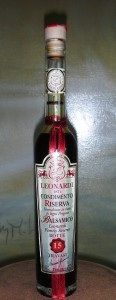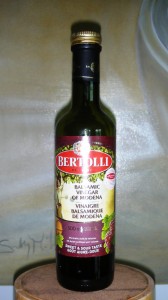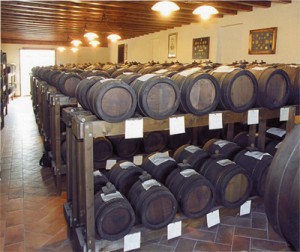 When we left Florence this summer, I had secreted a bottle of twelve year old balsamic vinegar I had bought in the Mercato Centrale. Wrapped tightly in a pair of jeans and tucked into the bottom of my suitcase, it made it safely back to Manila – although I will not confess here what I paid for it, for fear my husband will read this and blanch, but I was advised it would be worth every euro!
When we left Florence this summer, I had secreted a bottle of twelve year old balsamic vinegar I had bought in the Mercato Centrale. Wrapped tightly in a pair of jeans and tucked into the bottom of my suitcase, it made it safely back to Manila – although I will not confess here what I paid for it, for fear my husband will read this and blanch, but I was advised it would be worth every euro!
Apparently a form of balsamic vinegar was documented in 1000AD, but the first official balsamic vinegar originated in the Middle Ages in Modena and Reggio Emilia, Italy, as a health tonic or digestivo at the end of a heavy meal. Today its production is strictly regulated by EU law. These days you probably all have a bottle of balsamic vinegar in your pantry, but although it has been popular in Italy for centuries, it was little known to the rest of the world until the 1970s. Like wine, it can range from the sublime to the ridiculously ghastly.
Here are a few more facts about balsamic vinegar you might not know. There are two main types of balsamic vinegar:
1. Aceto Balsamico Tradizionale di Modena
The authentic balsamic vinegar must be aged in wooden barrels for at least twelve years, the key to its flavour being the annual decanting into ever-decreasing barrels. The barrels are made from woods such as chestnut, acacia, cherry, oak, mulberry and ash, each adding a distinctive flavour to the resulting vinegar. The final syrup is highly concentrated, sweet, rich and viscous, and deep reddy-brown in colour If it is aged for over twenty five years, it is known as extravecchio or stravecchio.
2. Aceto Balsamico di Modena
 This is an inexpensive commercial imitation of the traditional product. It is widely available and much better known, used in salad dressings, marinades and sauces. Such commercial products ape the traditional product by blending wine vinegar with caramel and thickeners. No aging process is involved, and hundreds of thousands of litres can be produced every day.
This is an inexpensive commercial imitation of the traditional product. It is widely available and much better known, used in salad dressings, marinades and sauces. Such commercial products ape the traditional product by blending wine vinegar with caramel and thickeners. No aging process is involved, and hundreds of thousands of litres can be produced every day.
Balsamic vinegar is made from either the pressings of white Trebbiano and Sauvignon grapes or Lambrusco grapes. The ‘must’ is boiled down to syrupy reduction, then fermented and aged in wooden barrels. The aging thickens the vinegar and concentrates the flavour. Every year the vinegar is decanted into a smaller cask. In the end, 2.5 – 5 litres of balsamic vinegar are created from every 100kg grapes.
Today Reggio Emilia designates the different ages of their balsamic vinegar (Aceto Balsamico Tradizionale di Reggio Emilia) by the colour of the label. A red label means the vinegar has been aged for twelve years, a silver label says the vinegar has aged for a minimum of 18 years and a gold label indicates over twenty five years of aging. In Emilia-Romagna, balsamic vinegar is most often served in drops on top of chunks of Parmigiano Reggiano and mortadella as an antipasto. It is also used lightly to enhance steaks, eggs or grilled fish, simple pastas or risotto, on fresh fruit such as strawberries and figs, peaches and pears, or to enliven a crema gelato.
Aceto Balsamico Tradizionale di Modena uses a different system. A cream-coloured cap means the vinegar has been aged for at least twelve years, while a magenta cap bearing the designation extravecchio (extra old) indicates the vinegar has been aged for at least twenty five years. Three popular desserts in Modena improve with a splash of balsamic vinegar: zabaglione, latte alla portoghese ( or crème caramel), and panna cotta.
 Last night I opened my test tube sized bottle of ancient balsamic vinegar and, while I did feel the bottle should be covered in cobwebs and dust at the very least, the product was heavenly. Dripping a raindrop of vinegar onto the end of my finger, it looks and tastes distinctly different from the commercial brand. It is aromatic, thick and syrupy and pours o-so-slowly out of the narrow-necked bottle. The anticipation is worth it – this aged vinegar is so much more complex than the cheaper brand. But when drizzled over the salad (what’s the opposite of copiously?), well, to to be honest, it might just as well have been a commercial brand. I feel very grown up owning such a highly prized bottle of balsamic vinegar, but I am obviously no connoisseur yet!
Last night I opened my test tube sized bottle of ancient balsamic vinegar and, while I did feel the bottle should be covered in cobwebs and dust at the very least, the product was heavenly. Dripping a raindrop of vinegar onto the end of my finger, it looks and tastes distinctly different from the commercial brand. It is aromatic, thick and syrupy and pours o-so-slowly out of the narrow-necked bottle. The anticipation is worth it – this aged vinegar is so much more complex than the cheaper brand. But when drizzled over the salad (what’s the opposite of copiously?), well, to to be honest, it might just as well have been a commercial brand. I feel very grown up owning such a highly prized bottle of balsamic vinegar, but I am obviously no connoisseur yet!

I was once out with Italians for dinner in Italy and they wanted me to have T-bone steak. Why an Italian would try and impress an Australian with meat was beyond me. The meal arrived.
Plate and a steak.
Nothing else.
No veggies, no salad, no potatoes, no sauces – nothing but plate and steak.
But what a steak – and the secret?
It had been grilled with a splash of aged balsamic vinegar. Try it. Its worth it. And keep some good Italian bread nearby to mop up the juices.